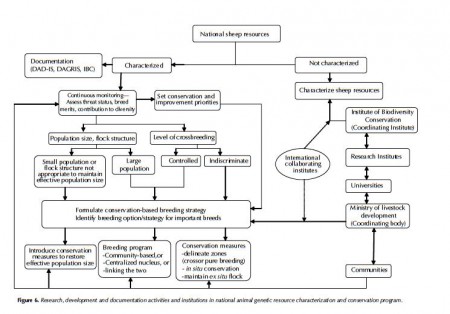ILRI’s research report “Characterization and conservation of indigenous sheep genetic resources: A practical framework for developing countries” has a nifty flow diagram at the back which sort of summarizes what you have to do as a national programme to conserve your indigenous sheep breeds. I don’t think it would need to be tremendously dissimilar to be applicable to crop landraces. Any thoughts?
Brainfood: Sorghum core diversity, Indian mango diversity, Montia potential, Assisted migration, Corchorus diversity, Soil DNA, Fire!, Coffee pest, Earthworms
Making life simpler for you, we have created an open Mendeley group for the papers we link to here. If you’re already using Mendeley, feel free to join the group (and use it to suggest papers we might miss). You can also discuss papers there, but frankly, we’d prefer you to do that here. Or on Facebook. Even if you don’t use Mendeley, you can subscribe to the RSS feed from the group and get stuff that way. Are we cool, or what?
- Variation in flowering time in sorghum core collection and mapping of QTLs controlling flowering time by association analysis. 4 QTLs and 7 loci detected under different conditions. Is that, like, a lot?
- Evaluation of genetic diversity among commercial cultivars, hybrids and local mango (Mangifera indica L.) genotypes of India using cumulative RAPD and ISSR markers. Just one big happy family.
- Montia fontana L. (Portulacaceae), an interesting wild vegetable traditionally consumed in the Iberian Peninsula. Aquatic herb has high fibre and lipids. High oxalate too though. Breeders enjoined to get to work. On Montia. Riiiiight.
- Taking stock of the assisted migration debate. It’s REALLY complicated. Scientists are not that great at explaining it. More work needed all round. But now we have fancy diagrams.
- Genetic diversity and relationships in Corchorus olitorius (Malvaceae s.l.) inferred from molecular and morphological data. Out of Africa. Ethiopia, to be exact.
- Meta-barcoding of ‘dirt’ DNA from soil reflects vertebrate biodiversity. Wonder whether it works with agricultural ‘dirt.’
- The human dimension of fire regimes on Earth. Entertaining gallop through the history of the use of fire to manage landscapes around the world and down the ages. Need to catch my breath here.
- Some like it hot: The influence and implications of climate change on coffee berry borer (Hypothenemus hampei) and coffee production in East Africa. That title just had to come sometime, didn’t it.
- A critique of earthworm molecular phylogenetics. So apparently “molecular phylogenetics is now on the verge of revolutionizing earthworm systematics.” Beyond satire.
Nibbles: Primary forests, Lima Declaration
- “…old-growth rainforests are the greatest celebration of life on earth.” Well, maybe.
- Chefs make a stand. Ooooooh, scary.
Nibbles: Mexican avocado prices, Marijuana in Central Asia, CWR in USA, Royal garden, Iraqi dates
- Mexicans can’t afford avocados.
- “Vostok — delo tonkoe, Petrukha!“
- New blog on crop wild relatives in the US, courtesy of our friend Colin.
- Royal villa has nice garden shock.
- “Three-quarters of date palm trees in Iraq right now … are of just one variety.”
Brainfood: Millet diversity, Maize landraces and hybrids, Potato carotenoids, Wheat domestication, Value chains, Population modeling, Rhizobium diversity, Yeast diversity, Core collection, Wild Zea, Cotton geneflow, Forest fires, Forest diseases
- Identification of trait-specific germplasm and developing a mini core collection for efficient use of foxtail millet genetic resources in crop improvement. All the goodness of Setaria italica diversity in just 35 accessions.
- Farmers’ adoption of maize (Zea mays L.) hybrids and the persistence of landraces in Southwest China: implications for policy and breeding. There are pros and cons to both hybrids and landraces, and participatory plant breeding could bring together the pros and get rid of the cons.
- Carotenoid concentrations of native Andean potatoes as affected by cooking. Some carotenoids were decreased by boiling, others not so much.
- Domestication evolution, genetics and genomics in wheat. A big summary of what we know so far and what we might learn by sequencing some wild wheat relatives.
- Research Principles for Developing Country Food Value Chains. Multidimensional demands by consumers demand multidimensional research by scientists. I think.
- Range shift promotes the formation of stable range edges. Species can move for reasons other than climate change.
- Genetic diversity of rhizobia associated with indigenous legumes in different regions of Flanders (Belgium). A new genus? In Flanders?
- Assessment of yeast diversity in soils under different management regimes. Type of management and vegetation has an effect. Yeah, well, you had to be there.
- Efficiency of PowerCore in core set development using amplified fragment length polymorphic markers in mungbean. Software for making core collections seems to work.
- Three new teosintes (Zea spp., Poaceae) from México. New entities, apparently. Species? Subspecies? More study needed, natch.
- Recent long-distance transgene flow into wild populations conforms to historical patterns of gene flow in cotton (Gossypium hirsutum) at its centre of origin. Four out of eight populations have transgenes.
- Effectiveness of strict vs. multiple use protected areas in reducing tropical forest fires: A global analysis using matching methods. Indigenous areas and multiple use are best.
- The sudden emergence of pathogenicity in insect–fungus symbioses threatens naive forest ecosystems. It can happen anywhere, any time.
